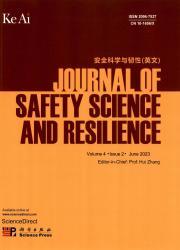开发架空电力电缆的安全性和弹性框架:使用模糊推理系统进行风险和可靠性分析
IF 3.4
Q1 PUBLIC, ENVIRONMENTAL & OCCUPATIONAL HEALTH
引用次数: 0
摘要
在老化的基础设施中,确保架空低压(LV)和中压(MV)电力电缆的安全性、弹性和可靠性对于维持配电系统的基本服务和降低风险至关重要。本研究引入了一个新的框架,该框架集成了故障树分析(FTA)/故障模式和影响分析(FMEA)以及模糊推理系统(FIS),以系统地解决性能变化问题,并在确保安全性和弹性的同时提高这些关键资产的使用寿命。该结构框架采用了风险知情决策以及基于可靠性的安全性和弹性保证,并结合了国际标准和最佳实践。在这种方法下,FIS对资产绩效中的不确定性进行建模,使用专家定义的规则和成员函数对风险级别进行分类并评估失败严重程度。以架空中压电力电缆为例,具体介绍了“浣熊”全铝合金导体(AAAC)的实际应用情况。结果表明,在典型环境条件和设计参数下,导线的年可靠度接近1,符合IEC标准。以载流容量(CCC)、故障模式(FTA)为发生概率,以断电时间(PSD)为严重程度指标,建立了风险矩阵。风险矩阵根据CCC和PSD输入估计潜在风险(PR)水平。例如,当CCC = 260 A, PSD = 50 min时,结果PR为12.9,表明存在中等风险。这些风险级别指导适当的弹性行动,通过识别关键风险、优先考虑缓解措施以及确保适应性和合规性,确保主动的电力电缆管理。这种方法不仅解决了基础设施老化的挑战,而且有助于长期的系统完整性和运行可靠性。本文章由计算机程序翻译,如有差异,请以英文原文为准。
Development of a framework for safety and resilience in overhead power cables: Use of a fuzzy inference system for risk and reliability analysis
Ensuring the safety, resilience, and reliability of overhead low-voltage (LV) and medium-voltage (MV) power cables in aging infrastructure is vital for maintaining essential services and mitigating risks in electrical power distribution systems. This study introduces a novel framework that integrates fault tree analysis (FTA)/failure mode and effect analysis (FMEA) and a fuzzy inference system (FIS) to systematically address performance variability and enhance the operational life of these critical assets while ensuring safety and resilience. This structured framework employs risk-informed decision-making as well as reliability-based safety and resilience assurance, incorporating international standards and best practices. Under this methodology, the FIS models uncertainties in asset performance, using expert-defined rules and membership functions to categorize risk levels and assess failure severity. A case study is performed on overhead MV power cables, specifically the "Racoon" all-aluminum alloy conductor (AAAC), demonstrating its practical implementation. The results reveal that for typical environmental conditions and design parameters, the yearly reliability of the conductor is nearly 1, indicating compliance with IEC standards. Furthermore, a risk matrix is developed using current carrying capacity (CCC), a failure mode obtained from the FTA as the probability of occurrence, and power shutdown duration (PSD) as the severity indicator. The risk matrix estimates the potential risk (PR) level based on CCC and PSD inputs. For example, for CCC = 260 A and PSD = 50 min, the resulting PR is 12.9, indicating a moderate risk exists. These risk levels guide appropriate resilience actions, ensuring proactive power cable management by identifying critical risks, prioritizing mitigation measures, and ensuring adaptability and compliance. This approach not only addresses the challenges of aging infrastructure but also contributes to long-term system integrity and operational reliability.
求助全文
通过发布文献求助,成功后即可免费获取论文全文。
去求助
来源期刊

安全科学与韧性(英文)
Management Science and Operations Research, Safety, Risk, Reliability and Quality, Safety Research
CiteScore
8.70
自引率
0.00%
发文量
0
审稿时长
72 days
 求助内容:
求助内容: 应助结果提醒方式:
应助结果提醒方式:


